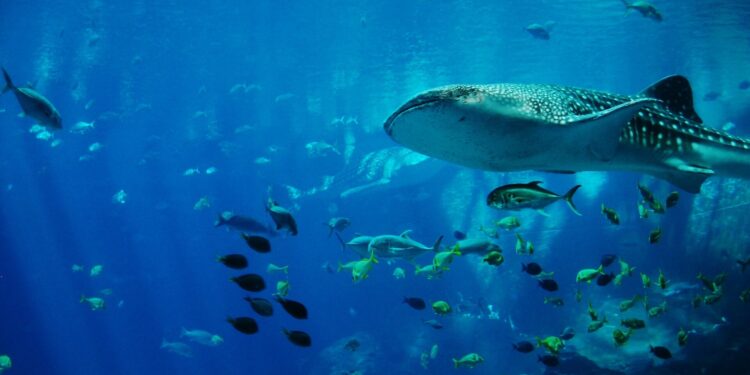Scientists have developed ZooMS, a new tool for understanding prehistoric pelagic fishing on ancient Pacific islands. Credit: www.publicdomainpictures.net/en/view-image.php?image=151142&picture=whale-shark-rhincodon-typus
A new collagen fingerprinting tool can help scientists identify species from archaeological bone fragments. The Pacific Islanders of the Late Stone Age, also known as the Neolithic period, were master fishermen. Archaeological evidence indicates that these groups caught fish both onshore and in open water.
Now researchers have found a way to shed light on the types of fish they feasted on and the advanced fishing techniques used to catch them. The new Zooarchaeology Mass Spectrometry (ZooMS) tool can detect the unique chemical fingerprint hidden in collagen, a structural protein that makes up the majority of bone mass.
Researchers tested 131 archaeological bones and accurately identified three varieties of tuna and five varieties of shark. The results are published in the Journal of Archaeological Sciences.
Visit Fais Island
Studies have shown that targeting fast-moving marine predators like sharks and tuna, also known as pelagic fishing, played an important role in how the early inhabitants of the Pacific islands survived and developed their culture.
Fais, a small raised coral island in the state of Yap in Micronesia, has become an area of archaeological interest. Several expeditions to the island led to the discovery of the archaeological site of Powa on its southern coast.
Map of Micronesia and the Pacific with the position of Fais Island, Powa Archaeological Site (FSPO) and Yap Island. Credit: Journal of Archaeological Sciences (2025). DOI: 10.1016/j.jas.2025.106386
By examining clues left in layers of soil beneath the surface, scientists discovered that Fais had been inhabited for nearly 1,800 years. The islanders relied heavily on pelagic fishing because navigating the surrounding coral reefs to catch inshore fish was quite tricky.
However, when researchers analyzed fish remains to identify shark and tuna species, traditional methods of comparing bones failed. These techniques made it difficult to identify fish beyond the family level, and the distinctive markings faded over time due to poor soil conservation conditions. Additionally, many of these fish have cartilage in their skeleton, which does not fossilize.
The researchers in this study provided a more reliable, chemistry-dependent method for distinguishing fish.
Mass fingerprinting of collagen peptides
This study used ZooMS, a collagen fingerprinting technique, to obtain much more precise results. The collected samples were processed using the acid-soluble collagen method, in which the bones were first dissolved in acid, which digested the collagen into peptides. Some bone samples were scrubbed with sandpaper rather than dissolved in acid to extract the collagen.
The extracted materials were then analyzed by mass spectrometry to produce unique collagen “fingerprints” which were compared to modern reference samples.
A- MALDI-ToF mass spectra of collagen digestions of the three archaeological taxa of scombrids discriminated in the study. B- Pie chart with NISP for each scombrid species identified. From top to bottom showing CB10, CB2 and CB1. Credit: Journal of Archaeological Sciences (2025). DOI: 10.1016/j.jas.2025.106386
The method identified 97% of bones in the tuna family with a high level of confidence. Of the 77 samples of these fish, 75 were skipjack and the other two were yellowfin and wahoo.
Shark remains showed greater variety. Although the reference database is incomplete for accurate identification, of the 50 samples successfully fingerprinted, 20 were closely related to the silky shark, 11 to the Galapagos shark, 17 to the silvertip shark, and one to the whitetip reef shark.
The researchers note that these results improve the accuracy of identifying ancient fish remains, giving us a clearer insight into historical fishing practices. They called for further studies to expand reference databases, thereby improving the potential of ZooMS.
Techniques at the molecular level can fill remaining gaps in species identification and improve our understanding of how fishing habits have shaped societies.
Written for you by our author Sanjukta Mondal, edited by Sadie Harley, and fact-checked and edited by Robert Egan, this article is the result of painstaking human work. We rely on readers like you to keep independent science journalism alive. If this reporting interests you, consider making a donation (especially monthly). You will get a without advertising account as a thank you.
More information:
Clara Boulanger et al, ZooMS as a tool for understanding prehistoric pelagic fishing: insight into the archaeological remains of sharks and scombrids on the island of Fais, Micronesia, over the last two millennia, Journal of Archaeological Sciences (2025). DOI: 10.1016/j.jas.2025.106386
© 2025 Science X Network
Quote: Stone Age fishing practices in the Pacific revealed through chemical fingerprints hidden in collagen (November 7, 2025) retrieved November 8, 2025 from
This document is subject to copyright. Except for fair use for private study or research purposes, no part may be reproduced without written permission. The content is provided for informational purposes only.



